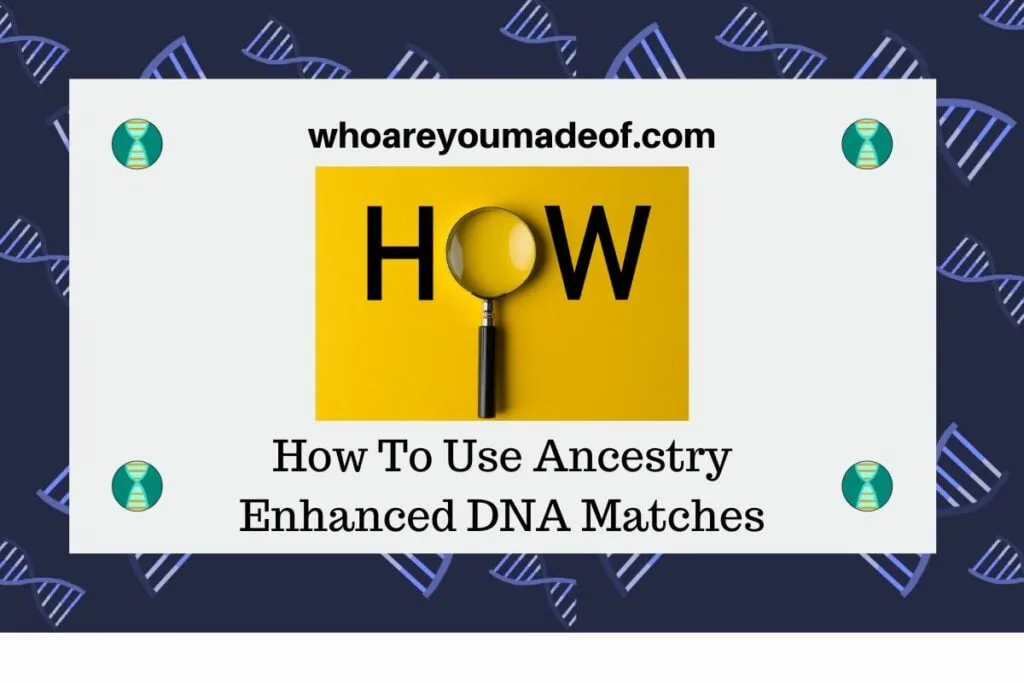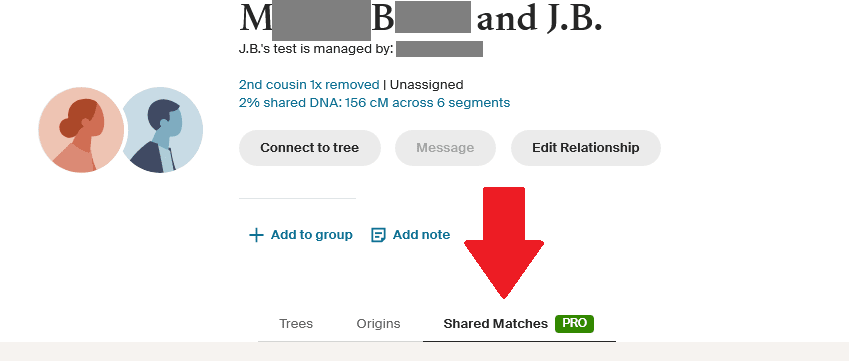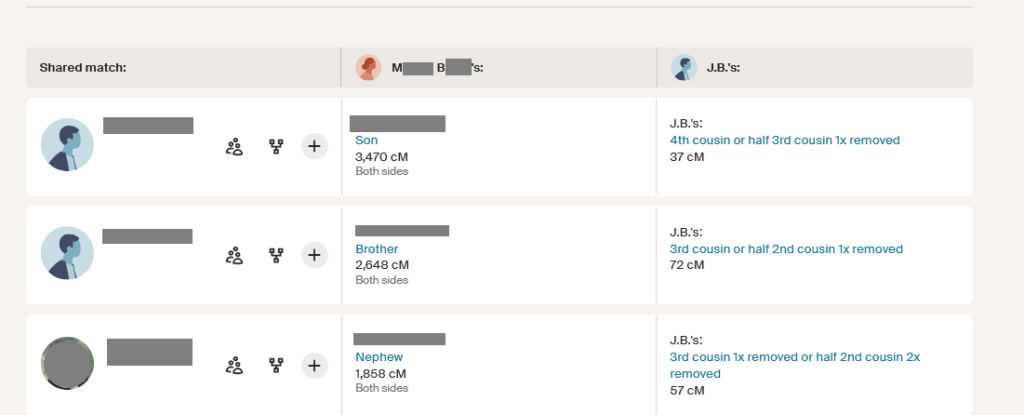Have you seen the Ancestry Enhanced DNA Matches feature? In this post, learn how to use it and what you can discover through using this tool.

Ancestry has been the best place for finding and learning from DNA matches for several years due to their sizeable DNA database and focus on family tree research. Many of the tens of millions of people who have tested their DNA with Ancestry have also built a family tree on the site and connected it with their DNA results.
It's always wonderful, however, when something that is great becomes even better. That's where the Enhanced Shared Matches feature comes into the discussion.
What are enhanced shared matches on Ancestry?
Enhanced Shared Matches are part of the Ancestry Pro Tools bundle. This bundle is available for $10 to current Ancestry subscribers, and contains a variety of helpful family tree and DNA tools.
With Enhanced Shared Matches, you will be able to see additional details about matches you share in common with someone. For example, you can now see how much DNA your shared matches share with the DNA match and their estimated relationship.
How to find the Enhanced Matches feature
If you have an active Pro Tools subscription, your Enhanced Matches features are automatically visible directly on your DNA match list. In order to see your enhanced shared matches information, simply navigate to a match that you would like to learn more about, and click on the "Shared Matches" tab.

You will then see all of the matches that you share in common with your DNA match, along with how much DNA they share with you and your match, along with the estimated relationship.
In the example below, you will see the matches that M.B. and J.B. share in common. The left column lists the name of the match, the middle column shows how much DNA they share with M.B, and the final column shows how much each shared match shares with J.B.

The matches are listed in order of most closely related to you by default, so I would recommend flipping though all of the pages of shared matches to see which shared matches are most closely related to your match. Finding those closer relationships will help you the most in learning about how you are connected to your DNA match.
What can you learn from this tool?
Using the extra information that you can learn from the Enhanced Shared Matches tool, you can take your DNA match research to the next level. Whether you working on a potential non-paternity event (NPE) in your family tree, or focusing on DNA matches to help build a wide family tree, you will find this tool to be very helpful.
I've only been using this tool for a few weeks, and already I have identified at least four different uses for the Enhanced Shared Matches in my own research. Below, I describe the methods that I am using to use this information and learn even more from my DNA matches.
Solve your relationship with mystery matches
Your Enhanced Shared Matches with Pro Tools can help you solve how you are related to those "mystery matches" more easily. In fact, you may even discover that you are able to work out how you are related very quickly.
The way this could work is like this: Find your mystery match with no family tree that you would like to learn more about, and take a look at your shared matches, with the Pro Tools activated.
Then, find the shared DNA matches that are most closely related to your mystery match. You may have to flip through a few pages of shared matches to find the closest relatives to your mystery match.
Take note of the estimated relationship suggested by Ancestry for those closest relatives to your DNA match. Then, identify which watches have a family tree attached to their DNA results.
If the shared DNA match is a sibling to your mystery match, then you don't need to look any further than the parents of the shared match to find their shared ancestor. Estimated first cousins will share an ancestor no further back than grandparents, and second cousins great-grandparents.
Once you know the ancestor they share in common, you can use the family tree information you have learned from the trees of the shared match(es) along with basic genealogy strategies to find how their family tree connects to yours. You can build a "quick and dirty" tree for your match as far back as you need to until you connect with a line of your family tree.
Since most of our mystery DNA matches are not too distantly related, this usually doesn't take very long, as long as there are no non-paternity events in any of the family trees involved.
Figure out how you are related to groups of matches
Since many of our DNA matches are related to each other as well, the Enhanced Shared Matches tool will help you work through your DNA match list more efficiently.
For example, you can use the extra details available with this tool to figure out how you are related to DNA matches that you share with relatives that you have already identified, and those that you identify in the future.
Once you learn how you are connected to one DNA match, you can go through your shared matches, using the amount of DNA they share with their matches as a guide, and learn where several other of your shared DNA matches belong in your family tree.
As you research, be sure to create custom color-coded groups on Ancestry to keep your DNA match list organized. This will also help you figure out how you are related to additional DNA matches in the future, as you will be able to find DNA matches in your custom groups as shared matches with other people.
Narrow down potential lines of your tree for DNA matches
Even when the information available to you is not enough to help you discover exactly how your DNA match is related, the enhanced information on your shared match list will help you further narrow down how a match might be related.
I've been working on a "mystery" DNA match for several years, who we will call "Martin". Martin shows up as a distant cousin for myself and my father, but he shares 76 centimorgans (cMs) with my paternal grandmother and 354 cMs with my great-uncle.
Using the list of estimated relationships between Martin and my grandmother and Martin and my great-uncle, I then figured out which relationships were possible for both amounts of shared DNA. The end result was my determination that the ancestor that my grandmother, her brother, and Martin share in common can be no further back than a great-grandparent for my grandmother.
The problem was that, according to Martin's family tree, we have no shared ancestors. He has a family tree going back several generations on all lines, and there are no names that are familiar to me. I have also spent a lot of time - with no luck - working on the family trees of his ancestors to identify if our shared ancestor is further back on their lines.
Using the regular version of shared matches and the Ancestry DNA Matches By Parent feature, I felt fairly confident that Martin was related to me through my grandmother's father's side of the family.
In fact, I suspected that someone in my grandmother's father's line of the family tree had fathered a child out of wedlock and that my DNA match, Martin, is descended from that person.
Using the Enhanced Shared Matches feature, I am now able to see how much DNA the matches I share in common with Martin share with him. Even though I don't know exactly how they are all related to him, I can use the amount of shared DNA to estimate where they belong in his family tree.
Using this information, I have been able to determine that I was right about my suspicion of my grandfather's father's paternal line. Our enhanced matches all indicate that he is descended from both of my great-great-great grandparents on that line of my family tree.
Conclusion
I hope that this post has helped you understand how to use the enhanced DNA match feature on Ancestry and how you can use the information available to you to learn more about your DNA matches.
If you have any questions about something that you read in this post, or if you would like to share a way that you have found to use enhanced DNA matches, I would love to hear from you in the discussion below.
Thank you for reading today!

Nick G
Thursday 6th of March 2025
If I have a match with person M1 and the shared matches list shows person M2. There are theoretically five cases. Let me share ancestor A with M1 and let me share ancestor B with M2 and let M1 share ancestor C with M2. At worst A, B and C are all different, at best A, B and C are all the same person. Does the enhanced tool allow me to establish what is the relationship between A, B and C?
gary haas
Sunday 29th of September 2024
I have ProTools. Navigating through 20+ webpages of shared matches is tedious. I am a computer geek. A general rule is if you can see it on the computer screen you can get the data into a database (Excel). I use Excel macros and Excel Power Query to extract GRANDPARENT, THRULINE, and MATCHES into Excel. Once in Excel you can do magic. Example: Excel can automatically calculate MRCA of matches with COMMON ANCESTORS. I can demonstrate to workbook to interested parties. Contact me directly through my email.
gary haas
Wednesday 2nd of October 2024
@D Gilson, contact me [email protected] - i too have multiple family matches to people - it works well for me - my workbook needs to be demonstrated
D Gilson
Sunday 29th of September 2024
@gary haas, your email does not come up for other viewers of this site (I believe that tool is turned off by default for all but the owner of the page). You might want to put your workbook data into a google drive or something similar.
I am interested in your workbook, but I come from a highly endogamous population, so it might well not work so easily for me for my own DNA, but I also manage tests for others.